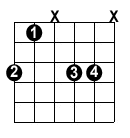
(audio example is G#/Ab, root on the 4th fret)
Fret/Chord Chart
You can determine the name of the chord when the root
(lowest) note is played on the frets in the chart below.
| Fret | 1 | 2 | 3 | 4 | 5 | 6 | 7 | 8 | 9 | 10 | 11 | 12 | 13 | 14 |
| Minor Chord | – | – | G Open | G#/Ab | A | A#/Bb | B | F | F#/Gb | G | G#/Ab | A | A#/Bb | B |
Alternate Fingerings
You may want to try one of the alternate fingerings below,
but there is no reason to learn every possible fingering.
Pick the fingering that works best for you and use that
one. Since we’re just switching a few fingers and notes
around we don’t need a new fret/chord chart, because this
pattern is still basically the same.

(audio example is G#/Ab, root on the 4th fret)
The alternate fingering below omits the root note. It
might sound a little different at first, but it’s still
a G minor chord. This is called an inversion. You’ll learn
more about inversions when you get to dominant 7th chords.
When you are fretting it imagine an invisible finger fretting
the root note or you may get in a bad habit of using the
note on the 5th string to name the chord, which would be
wrong.

(audio example is G#/Ab, root on the 4th fret)
Exercise
Pick the most comfortable barred fingering of the G minor
chord and play it up and down the fretboard starting at
the 1st fret and working your way up to the 12th fret.
The exercise is performed in the audio example below using
the 1st alternate fingering.